ABSTRACT
This bibliometric study explores the burgeoning field of social media banking, which merges banking services with social media platforms to facilitate customer access to financial services. Utilizing Scopus as the source for bibliographic data and adhering to PRISMA guidelines for document selection, the analysis employs bibliometric software tools such as Biblioshiny, VOSviewer, and CiteSpace to visualize and analyze key trends, themes, and influential contributors from 2007 to 2024. The study reveals significant annual growth in scientific production, with 2,494 authors contributing 794 documents, averaging 8.69 citations each. Prominent research clusters include the intersection of social media and banking, such as security, sentiment analysis, customer engagement, blockchain, and fintech. Citation bursts for keywords like “internet banking” and “social networking” indicate shifts in scholarly interest. Furthermore, the study identifies the most relevant authors, sources, and globally cited documents, while also exploring current trend topics, a thematic map, and bibliographic coupling. Visualizations like the co-occurrence of keywords and topic dendrograms provide deeper insights into developing themes and research connections. Notably, the role of social media platforms in banking has spurred extensive research into corporate reputation management, CSR communication, and financial technology. The study also highlights research gaps and practical implications, suggesting that banking institutions can innovate by leveraging social media strategies to enhance user experience and trust. In summary, the findings outline emerging opportunities and gaps, pointing to areas for future research and development in social media banking.
INTRODUCTION
Social media banking describes collaborative banking services through social networking sites to enable users to conduct financial transactions, receive customer support, and engage in banking products within their networks. As people increasingly adopt digital communication in all aspects of life, a new concept, social media banking, has dawned to foster innovation. Social media banking is the integration of social media platforms and banking services, creating a paradigm shift in customer-business interactions.[1,2] Nowadays, traditional banking setups, such as banking halls, have become obsolete and replaced with real-time, location-independent interactions enabled by digital technology.[3,4] In SMS, various platforms such as Facebook, Twitter, and Instagram are used to provide financial services, and bank customers can use these platforms to transfer funds, check their bank balance and even open new accounts.[5,6] The concept of social media banking emerged from the realization of banks that social media had a significant effect on consumer lifestyle and expectations.[7] Early on, banks used social media for marketing and to strengthen customer relations.[8] As digital trust grew, most banks provided shopping services.[8] By the beginning of the 20s, social media platforms that were initially used to communicate had become indispensable business platforms.[9] The broader fintech covers technology-driven innovations in financial services, social media banking applies to the use of social platforms such as Facebook, WhatsApp, and WeChat for financial interactions. For instance, in India, the likes of ICICI allow the checking of account balance and funds transfer over WhatsApp. In the same way, WeBank seamlessly integrates WeChat for complete digital banking services in China. The difference is an indication that while all applications of social media banking are from fintech, not every application from fintech originates from social media.
The main advantage of social media banking is improved convenience, which allows users to manage their financial transactions in addition to normal social interactions.[10,11] It also holds the potential for a more exciting user experience since social media platforms can support more engaging and interactive personal finance tools than banking apps.[12] In addition, this could maximize customer engagement, especially among young people who are more likely to avoid visiting the physical bank offices address to digital distribution.[13,14] On the other hand, the tool also has risks. For instance, the primary challenge is security since the concept of integrating financial services on platforms that were not originally designed for that purpose creates a great pool of fraud possibilities.[15] In addition, the concept is raised in regard to privacy and the use of data since users have to believe that their service operators use them responsibly.[16] Moreover, it still might not tackle banking needs that go beyond basic services provided, such as major loans and savings.[17]
In the future, social media banking is expected to grow significantly and it will also be the avenue for several other innovative developments. The use of blockchain technology or augmented reality could make the use of networks even more secure and consumer-focused.[16] AI and machine learning are still being developed, potentially allowing banks to offer more personalized advice or create even more responsive social media banking platforms.[18] Financial institutions are expected to form more partnerships with fintech companies to combine traditional banking with innovative solutions and traditional network services. The networking and the overall financial sector are changing, and banks will need to adjust to remain relevant while providing the kind of service customers expect and their safety.[19]
The intersection of digital communication technologies and financial services has created the field of social media banking, an essential area of investigation in the changing financial services environment. There is increased academic attention to this area and an equal focus of effort on mapping research trends, highlighting predominant themes, and indicating key players in this field. Bibliometric analysis is essential in scholarly research, and advanced software tools such as Biblioshiny, VOSviewer, and CiteSpace support it.[20–22] These tools enable comprehensive reviews and visualization of the complex weave of citations and collaborations that characterize social media banking, giving an insight into the intellectual landscape and the historical development of this multidisciplinary phenomenon.
Biblioshiny is a web-based application with a user-friendly graphical interface to manipulate bibliographic data using the bibliometrix R package.[23,24] It is very useful for descriptive statistics, citation analysis, co-citation analysis, and thematic mapping.[25–27] On the other hand, VOSviewer is extremely well-known for constructing detailed bibliometric networks about publications, such as journals, researchers, or single articles, by methods of co-citation, bibliographic coupling, and co-authorship.[24,28] Finally, CiteSpace is known for its trend analysis and detection capabilities, and with its powerful citation analysis function can uncover key papers and discipline-changing pivotal studies quickly and easily among all the rest in the network.[29,30] The tool is designed to quickly spot the most influential constituents of the map or clusters, showing comprehensive pictures of the network. These tools together provide a comprehensive package for analysing bibliometrics, offering a range of tools for handling and visualizing massive amounts of data, which are essential in a deep academic study.
This study seeks to address the following research questions: RQ1: What are the core research themes and emerging trends in social media banking? RQ2: Who are the key contributors, and what are their collaborative networks in the field? RQ3: How has the publication output in social media banking research evolved over time? RQ4: What are the most influential publications?
While much of the existing research on social media banking has explored qualitative aspects such as consumer behavior and the impact of social media on banking practices, there has been limited attention on bibliometric analyses that quantitatively map the evolution of research in this field. This study fills that gap by applying bibliometric tools like Biblioshiny, VOSviewer, and CiteSpace to analyze trends in citations, keyword co-occurrence, and co-citation networks within the realm of social media banking from 2007 to 2024. Unlike traditional literature reviews, our approach provides a comprehensive, data-driven perspective on how research themes have evolved over time. For example, while previous studies have highlighted topics such as consumer engagement and social media’s role in banking, our bibliometric analysis reveals the increasing prominence of technology-driven themes like fintech and blockchain. Additionally, citation bursts for keywords like “internet banking” and “big data” confirm the sustained interest in these areas, while recent bursts for terms like “coronavirus disease 2019” reflect the dynamic nature of research. These findings offer new insights into the shifting focus of social media banking research, providing a robust framework for understanding its current trajectory and emerging trends. This comparative approach, combining qualitative insights with quantitative bibliometric data, significantly enhances the overall understanding of the field’s development.
REVIEW OF LITERATURE
Boontarig and Srisawatsakul (2023) examine the teenagers’ adoption of social media banking in the region of Northeast Thailand. The researchers outline that they expand the UTAUT model with perceived convenience. The study is based on data collected from 159 individuals. Performance expectancy, social influence, and perceived convenience were confirmed as parts of the adoption intention. At the same time, facilitating conditions turned out to be insignificant. The outcomes of the research can be utilized by different stakeholders to efficiently utilize social media banking platforms to attract the young population. Therefore, with the help of this investigation, the scholars can depict the factors that affect the banking behavior of the younger generation due to social networking.[13]
Parusheva (2017) analyzes this question in the case of Bulgaria’s largest banks, reporting an example of nontransactional social banking. Based on the findings of online questionnaires and a review of banking practices, the researcher reflects that a younger generation is reluctant to maintain transactional features. However, this scepticism is anticipated with the high rates of fraud in Bulgarian banking institutions. To compel consumers, Bulgarian Bank offers more secure measures. Therefore, securing the use of social media helps banks develop their operations and expands the range of social media banking practices.[5]
Ho and Amin (2023) examine the influence of relationship commitment in the learning process of new financial products via social media based on issues critical to absorptive capacity and commitment-trust theories. From a survey of 248 bank fan page users, the authors found that high customer commitment leads to learning of new financial products through social media platforms. The paper is insightful in enhancing knowledge of how interaction and trust affect customer learning and product knowledge in the financial industry. The paper highlights the importance of social media as a strategic platform for enhancing financial knowledge and customer relations in banking.[31]
Majekodunmi (2017) reviewed the trajectory of the evolution of social media banking and its academic literature with respect to banking services such as fund transfer and account management. The author demonstrated the increase in the usage of social media for banking and studied existing literature based on marketing and customer relationship management related to the banking industry. The study further entertained the fact that social media platforms have been used widely for customer engagement; however, the ability to seamlessly utilize the platforms for transaction banking has several potential opportunities and challenges. This article helped further understand the current research trend of social banking in terms of available services and research themes.[7]
Mani et al., (2019) studied how customers engage with bank pages on Facebook. The scholars generally explored how Indian banks use social media to increase their interaction with clients. As a result, the authors found that private-sector banks show more engagement than public-sector banks. More specifically, these interactions come in the form of likes, shares, and comments. The paper helps to understand how online strategies can help banks stay active and perform social media surveillance. Additionally, the articles prove that social media and other online platforms can help businesses create an excellent reputation and improve their services based on feedback.[32]
Parusheva (2019) analyses the corporate side of social media banking using the example of the top ten banks in Bulgaria. The paper provides a more detailed definition and structure of the social media sphere within banking and examines the level of intensity with which banks use social media, including their strategies and practices. In addition, the author identifies possible loopholes that need to be developed and directions for further study. This study sheds light on the more detailed integration of social media into the practice of banking and its significance in more rational management for creating customer-oriented services.[6]
METHODOLOGY
The data collected for this study was obtained from Scopus, which provides extensive coverage of scholarly literature across various disciplines.[33,34] Scopus was chosen because it indexes peer-reviewed journals, conference proceedings, and book chapters comprehensively, ensuring a broad retrieval of relevant documents related to social media banking. A unique set of keywords was used to gather data pertinent to social media banking. The search words used were “social media” and “bank” or “social media banking”. These keywords would secure all relevant articles discussing any aspect relating to the integration of banking services with social media platforms. All searches were done without restrictions to languages since significant research output is from across the globe, which helped increase diversity in the data to be consulted. The PRISMA diagram in Figure 1 illustrates the systematic process followed in identifying, screening, and including relevant articles for the review. Initially, the search query used to identify documents, which resulted in a total of 937 records retrieved from the Scopus database. This search served as the basis for the identification phase. During the screening process, a total of 138 records were excluded based on the document types, which included Review articles, Conference Reviews, Books, and Notes. After applying these exclusion criteria, 794 records remained for further assessment. These records were then considered for inclusion in the review. In the inclusion phase, the remaining 794 records were classified into three distinct categories. 507 articles, 86 book chapters, and 201 conference papers were included in the final review. This division of records is critical for ensuring a comprehensive analysis of relevant literature across different types of academic publications. The results were saved as “CSV” files and RIS, and bibliometric analysis was carried out on the data using CiteSpace version 6.2.R3 Advanced and Biblioshiny software, respectively.

Figure 1:
PRISMA Flow diagram used to Identify, Screen, and Include papers in the Bibliometric Analysis.
Table 1 provides a detailed summary of the bibliometric analysis of social media banking from 2007 to 2024. The analysis encompasses 794 documents sourced from 631 different journals, books, and other publications, demonstrating a robust annual growth rate of 27.83%. The documents have an average age of 4.13 years, highlighting the contemporary nature of the research. Each document averages 8.69 citations, with a total of 30,691 references cited across all documents. The content analysis reveals 3,331 unique Keywords Plus and 2,309 author keywords. The study involved contributions from 2,494 authors, with 121 single-authored documents. Collaboration is significant, with an average of 3.4 co-authors per document and 19.65% of the documents featuring international co-authorship. The document types analyzed include 507 articles, 86 book chapters, and 201 conference papers, indicating a diverse range of publication formats within the field.
| Description | Results |
|---|---|
| Main Information About Data | |
| Timespan | 2007:2024 |
| Sources (Journals, Books, etc.) | 631 |
| Documents | 794 |
| Annual Growth Rate % | 27.83 |
| Document Average Age | 4.13 |
| Average citations per doc | 8.69 |
| References | 30691 |
| Document Contents | |
| Keywords Plus (ID) | 3331 |
| Author’s Keywords (DE) | 2309 |
| Authors | |
| Authors | 2494 |
| Authors of single-authored docs | 121 |
| Authors Collaboration | |
| Single-authored docs | 136 |
| Co-Authors per Doc | 3.4 |
| International co-authorships % | 19.65 |
| Document Types | |
| Article | 507 |
| Book chapter | 86 |
| Conference paper | 201 |
RESULTS
Annual Scientific Production
Figure 2 illustrates the annual scientific production in the field of social media banking from 2007 to 2024, revealing distinct phases of growth and significant trends. During the early phase (2007-2010), research activity was minimal, with only three articles published in total (one each in 2007, 2009, and 2010) and none in 2008, reflecting the nascent stage of academic interest in this area. From 2011 to 2015, a period of initial growth emerged, with publications increasing from 3 articles in 2011 to 31 articles in 2015-an approximate 933% growth over five years. This steady rise signifies growing recognition of social media’s role in banking. The period from 2016 to 2020 marked accelerated growth, with research output surging from 38 articles in 2016 to 89 articles in 2020, representing a significant 134% increase. This sharp rise aligns with the growing adoption of social media by financial institutions and heightened academic focus on its implications. From 2021 to 2024, research reached its peak and showed fluctuations. The number of publications peaked at 109 articles in 2021, reflecting a 22.5% increase from 2020, followed by a slight decline to 98 articles in 2022. In 2023, output rebounded strongly, reaching an all-time high of 136 articles, a 24.8% increase compared to the previous peak in 2021. As of July 2024, 65 articles have been published, suggesting a potentially strong year-end total. Overall, the data highlights a consistent upward trajectory in research output, particularly from 2011 onward, with substantial growth during 2016-2023 reflecting the increasing integration of social media in banking. The dip in 2022 could be attributed to external disruptions, such as the residual effects of the COVID-19 pandemic, but the field’s strong recovery in 2023 underscores its resilience and continued relevance. By defining intervals and analyzing changes as percentages, this explanation provides a clearer understanding of publication trends.
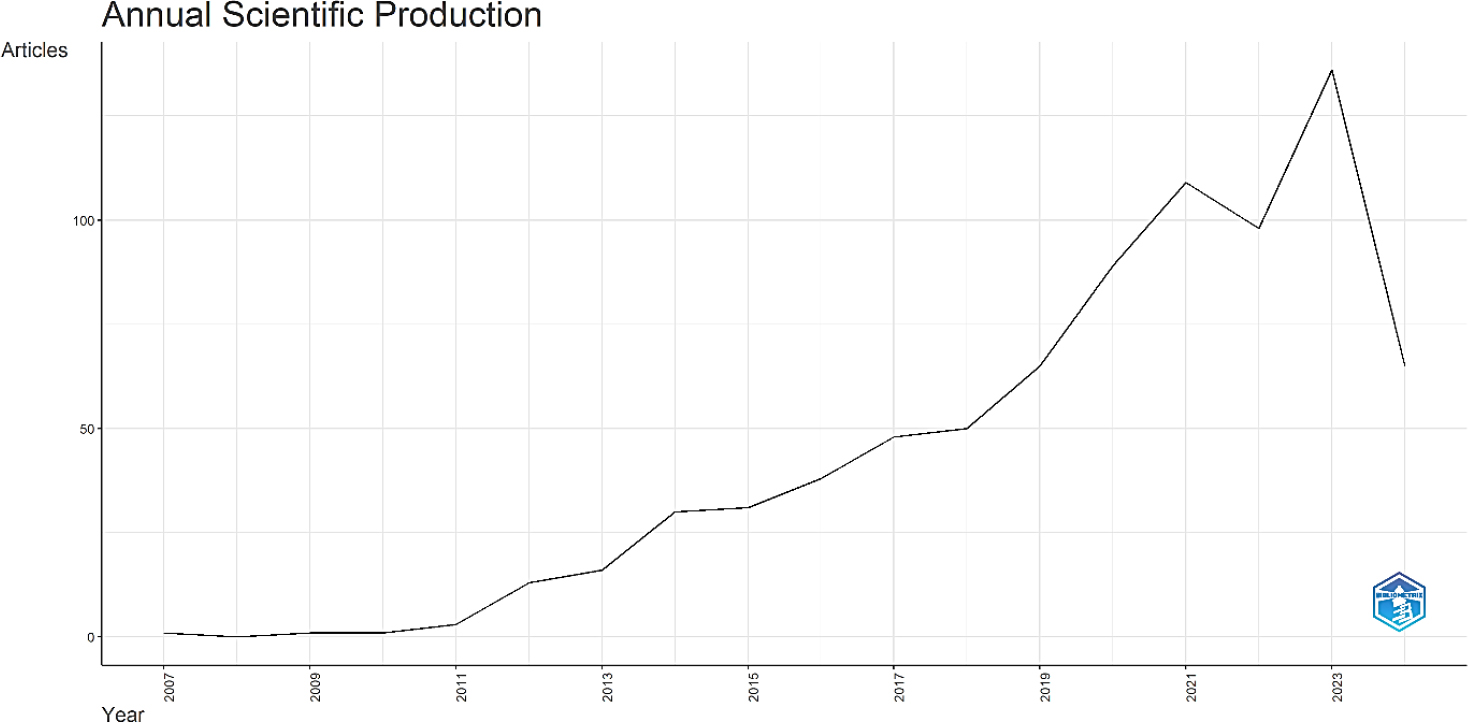
Figure 2:
Annual Scientific Production.
Most Relevant Authors
Table 2 lists the most prolific authors in the field of social media banking research, indicating their potential relevance and influence based on the number of articles published. Ahmad N stands out as the most productive author with six articles, suggesting a significant contribution to advancing research in this domain. Close behind are Bolat N, Chandani A, Mehta M, Naeem M, Sharma M, and Taskiran N.O, each with five articles, underscoring their substantial and consistent academic output. Presumably, these authors encompass different critical aspects of social media banking, driving theoretical and practical progress in the area. Madsen V.T, Neeraja B, and Ravi V, with four articles each, are slightly less prominent contributors. However, their continued research indicates a comprehensive focus on the specialized areas of social media banking. Clearly, their support has been essential in promoting the discourses that define this field, and it is likely that these authors have a significant influence on current research directions and future social banking trends.
| Authors | Articles |
|---|---|
| Ahmad N | 5 |
| Bolat N | 5 |
| Taskiran NO | 5 |
| Chandani A | 4 |
| Madsen VT | 4 |
| Mehta M | 4 |
| Naeem M | 4 |
| Sang NM | 4 |
| Setiawan EB | 4 |
| Sheela T | 4 |
Most Relevant Sources
Table 3 lists the most impactful sources based on the number of publications. The “Journal of Islamic Marketing” leads with 9 articles, indicating its significant contribution to the research in this area. The “ACM International Conference Proceeding Series” and “Communications in Computer and Information Science” both have 8 articles each, highlighting their importance as platforms for disseminating research findings. “Biopreservation and Biobanking” and the “International Journal of Bank Marketing” each have 7 articles, showing their relevance in the context of social media banking research. Other notable sources include the “AIP Conference Proceedings,” “Banks and Bank Systems,” “BMJ Open,” and “Sustainability (Switzerland),” each with 6 articles. The “International Journal of Recent Technology and Engineering” rounds out the list with 5 articles. This distribution demonstrates a diverse range of journals and conference proceedings contributing to the body of knowledge in social media banking, reflecting the interdisciplinary nature of this research field.
| Sources | Articles |
|---|---|
| Journal of Islamic Marketing | 9 |
| ACM International Conference Proceeding Series | 8 |
| Communications in Computer and Information Science | 8 |
| Bio preservation and Biobanking | 7 |
| International Journal of Bank Marketing | 7 |
| AIP Conference Proceedings | 6 |
| Banks and Bank Systems | 6 |
| BMJ Open | 6 |
| Sustainability (Switzerland) | 6 |
| International Journal of Recent Technology and Engineering | 5 |
Most Global Cited Documents
Table 4 lists the most globally cited documents in the field of social media banking, including their DOI, total citations, citations per year (TC per Year), and normalized citation counts. The most cited paper is by Wesselius HM, 2018, in JAMA Intern Med, with 176 citations, 25.14 citations per year, and a normalized count of 10.05, indicating significant impact. Bonson E, 2011, in Online Info Rev, follows with 118 citations, 8.43 per year, and a normalized count of 2.44. Wahlster S, 2021, in Chest, boasts 110 citations, the highest TC per Year at 27.5, and a normalized count of 9.15. Other notable papers include Mitic M, 2012, in Mark Intell Plann, with 98 citations and a normalized count of 5.04, Alhabash S, 2015, in Mass Commun Soc, with 90 citations and a normalized count of 5.24, and Tran HTT, 2016, in Int J Bank Mark, with 81 citations and a normalized count of 6.44. Chikandiwa ST, 2013, in Eur Bus Rev, has 80 citations and a normalized count of 4.14, Wulf V, 2013, in Conf Hum Fact Comput Syst Proc, has 79 citations and a normalized count of 4.09, Teng S, 2021, in Comput Hum Behav, has 76 citations and a normalized count of 6.32, and Tackett S, 2018, in Acad Med, has 73 citations and a normalized count of 4.17. Overall, these documents are highly influential, with significant citations reflecting their impact on social media banking research. The normalized citation count allows comparison across publication years, highlighting both foundational and recent influential studies. The normalized citation counts presented were generated using the Biblioshiny tool. These counts adjust for differences in citation behavior across years, allowing for a fair comparison between papers published in different periods. Older papers typically accumulate more citations over time, so normalization accounts for this factor, providing a more accurate measure of a paper’s relative impact within the field of social media banking. This methodology ensures that the citation counts reflect the true influence of each paper, regardless of its publication year.
| Paper | DOI | Total Citations | TC per Year | Normalized TC |
|---|---|---|---|---|
| Wesselius Hm, 2018, Jama Intern Med | 10.1001/jamainternmed.2018.2669 | 176 | 25.14 | 10.05 |
| Bonsa N E, 2011, Online Info Rev | 10.1108/14684521111113579 | 118 | 8.43 | 2.44 |
| Wahlster S, 2021, Chest | 10.1016/j.chest.2020.09.070 | 110 | 27.5 | 9.15 |
| Mitic M, 2012, Mark Intell Plann | 10.1108/02634501211273797 | 98 | 7.54 | 5.04 |
| Alhabash S, 2015, Mass Commun Soc | 10.1080/15205436.2014.945651 | 90 | 9 | 5.24 |
| Tran Htt, 2016, Int J Bank Mark | 10.1108/IJBM-06-2014-0073 | 81 | 9 | 6.44 |
| Chikandiwa St, 2013, Eur Bus Rev | 10.1108/EBR-02-2013-0013 | 80 | 6.67 | 4.14 |
| Wulf V, 2013, Conf Hum Fact Comput Syst Proc | 10.1145/2470654.2466262 | 79 | 6.58 | 4.09 |
| Teng S, 2021, Comput Hum Behav | 10.1016/j.chb.2021.106778 | 76 | 19 | 6.32 |
| Tackett S, 2018, Acad Med | 10.1097/ACM.0000000000002118 | 73 | 10.43 | 4.17 |
Trend Topics
The Trend Topics in Figure 3 illustrate the evolution and frequency of various research terms in the field of social media banking from 2012 to 2024, with terms listed on the y-axis and the timeline on the x-axis. The size of the bubbles represents term frequency, with larger bubbles indicating higher occurrences. Key observations include the emergence of recent high-frequency terms like “food insecurity,” “sentiment analysis,” “coronavirus disease 2019,” and “COVID-19,” predominantly appearing after 2019 due to the pandemic. Terms such as “social media,” “human experiment,” “learning systems,” “controlled study,” and “big data” have shown sustained interest over time, with “social media” and “big data” particularly notable for their consistent and growing presence. Emerging topics like “natural language processing systems,” “information dissemination,” and “surveys and questionnaires” suggest new research trends. In contrast, terms like “world wide web” and “internet banking” were more prevalent in earlier years but have declined, reflecting shifts in research focus. Meanwhile, terms like “sales,” “banks,” “competition,” and “mobile banking” have maintained moderate but consistent interest. This chart highlights the dynamic nature of research topics in social media banking, showing how certain topics have emerged, grown, or declined in prominence, providing insights into the evolving landscape of research priorities and interests within this field.
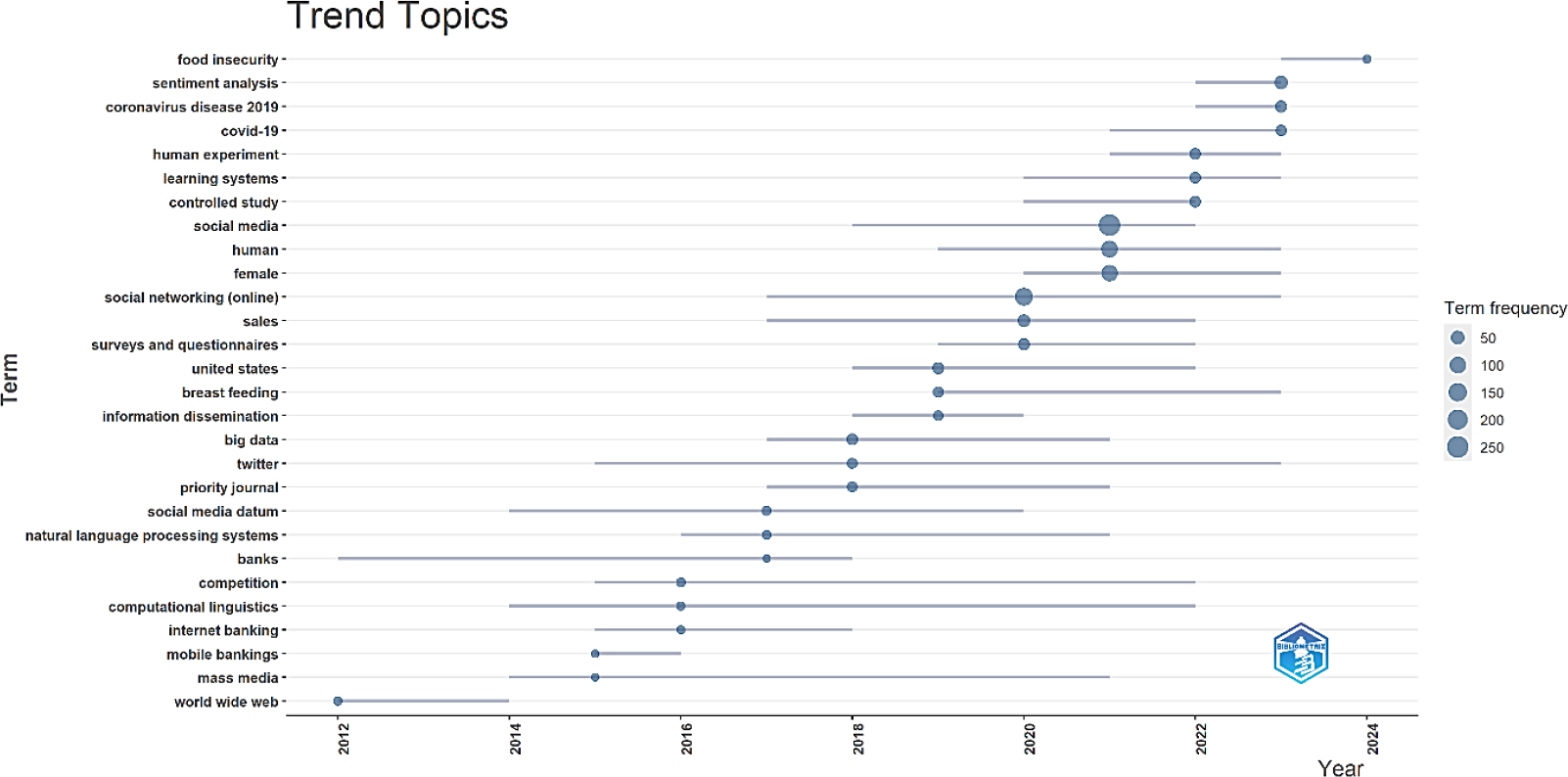
Figure 3:
Trend Topics.
Thematic Map
Figure 4 provides a thematic visualization of keywords in social media banking research, plotted on a two-dimensional space with development degree (density) on the y-axis and relevance degree (centrality) on the x-axis, divided into four quadrants representing different thematic categories. Niche Themes (upper left) include specialized topics like “survey,” “Islamic banks,” “Islamic banking,” and “consumer” that are well-developed but not central to the broader field. Motor Themes (upper right), such as “blockchain,” “technology,” “fintech,” “crowdfunding,” “trust,” “customer loyalty,” “social media marketing,” “customer engagement,” and “digital marketing,” are both highly developed and central, driving the research forward. Emerging or Declining Themes (lower left), like “sentiment,” “artificial intelligence,” “big data,” “classification,” “data mining,” and “digital bank,” are less developed and less central, suggesting they are either new areas of research or declining in interest. Basic Themes (lower right), including “social media,” “Twitter,” “sentiment analysis,” “banks,” “internet banking,” “COVID-19,” “privacy,” “security,” “ethics,” “natural language processing,” “internet,” and “Israel,” are fundamental and central to the field but not as specialized or developed as Motor Themes. This visualization highlights the focus and maturity of various research topics within social media banking, showing how certain themes drive the field while others serve as foundational or emerging areas of study.
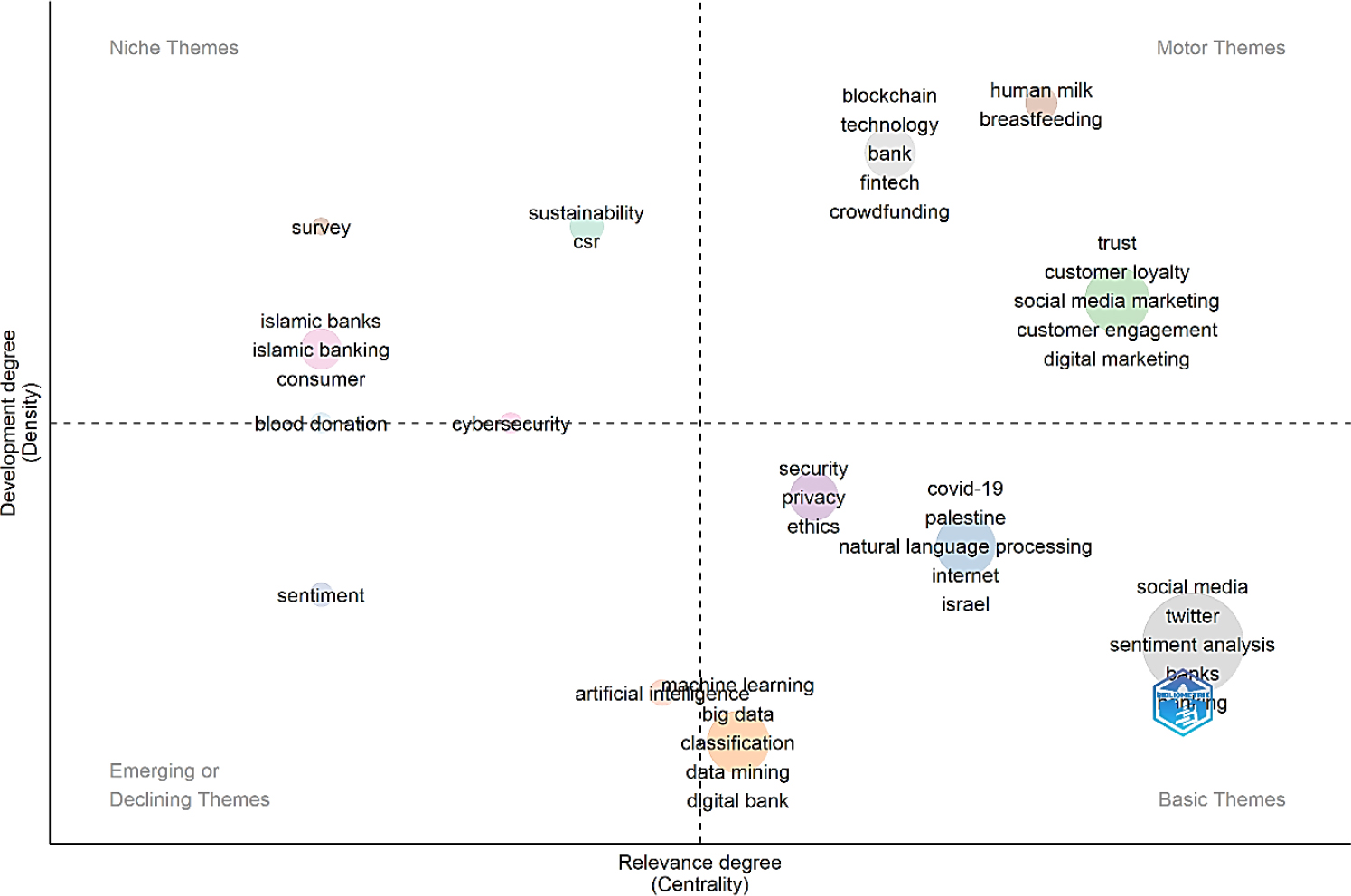
Figure 4:
Thematic Map.
Historiograph
Figure 5 presents a historiograph of influential documents in the field of social media banking, visualizing the citation relationships between key papers over time. Each node in the graph represents a paper, with the size of the node indicating the total number of citations, showing the relative impact of each publication. Edges between the nodes represent citation connections, with stronger or more frequent citations leading to closer, more tightly connected nodes. The color of the nodes reflects the year of publication, with earlier works displayed in darker shades and more recent papers in lighter colors, illustrating the evolving landscape of research. Clusters in the chart were identified using a citation-based clustering method, where groups of papers that cite each other most frequently are visually grouped together. These clusters represent distinct research themes or networks of influence. For example, the central cluster around Mitic M (2012) and Durkin M (2015) indicates foundational works that have influenced many subsequent studies. Other clusters, such as those around Parusheva S (2017) and Angelini A (2017), represent more recent developments and emerging topics in the field. The impact of publication years is evident in the distribution of clusters, with older papers forming the core of the network and newer studies, like those from Wang P (2021) and Torres P (2018), forming new connections and expanding the research frontier. This historiograph not only highlights key papers and their citations but also demonstrates how social media banking research has grown and diversified over time.
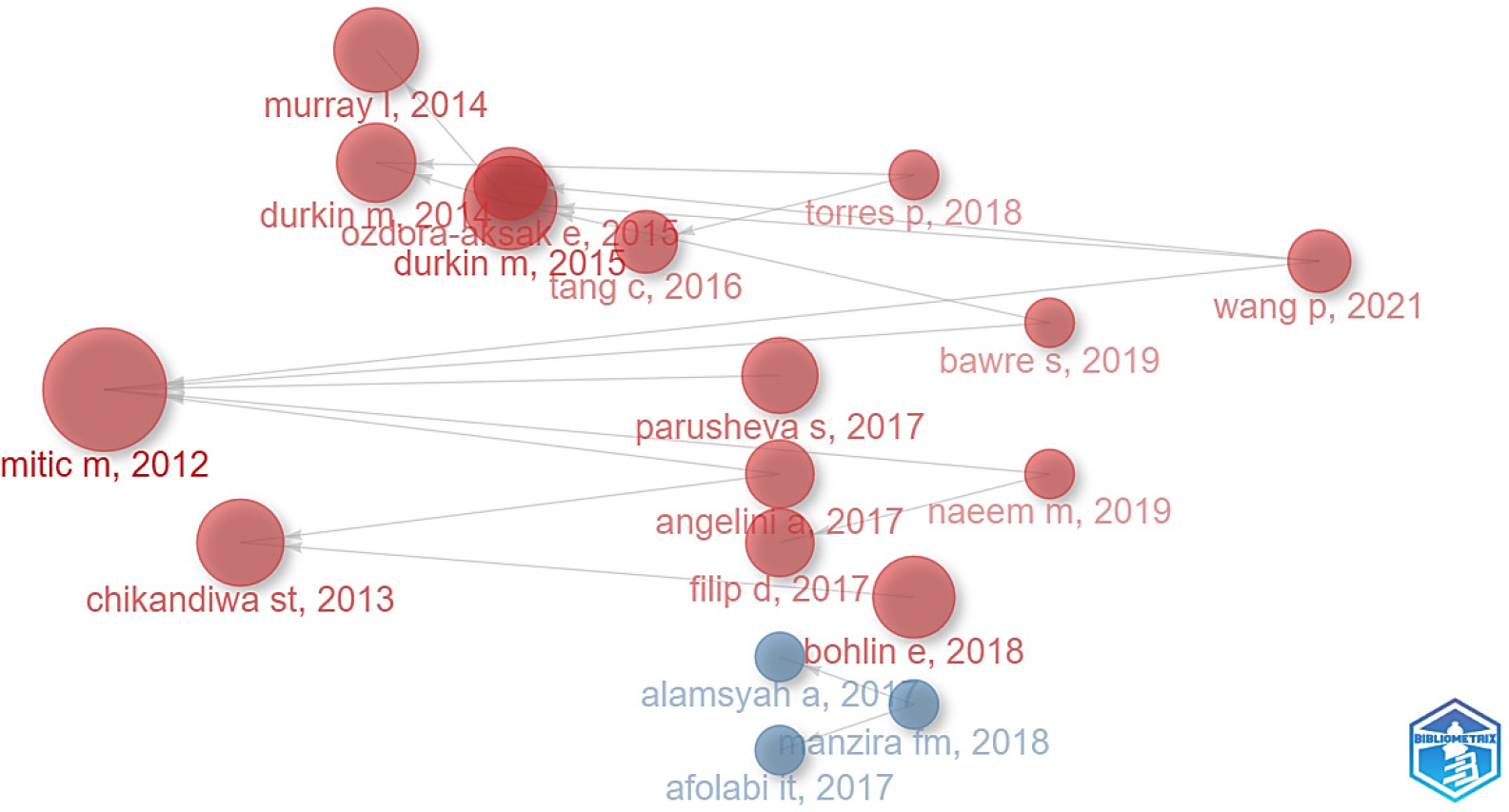
Figure 5:
Historiograph.
Topic Dendrogram
Figure 6 presents a topic dendrogram that visualizes the hierarchical clustering of research topics in social media banking, helping to identify how closely related various topics are based on their co-occurrence in the literature. The dendrogram’s branches illustrate the hierarchical relationships between the topics as they emerge: shorter branches separate related topics more closely. A few primary clusters are highlighted, with each broad thematic group represented by color. For example, there is a blue cluster far left featuring “Facebook,” “YouTube,” “corporate social responsibility,” and “Web 2.0”, indicating emphasis on particular social media platforms and their influence on corporate practices. The green cluster in the middle, with topics such as “banking industry,” “digital banking,” “artificial intelligence,” “machine learning,” and “COVID-19,” puts forth a track on technological advancement and their engagement in banking practices. The topics covered in the purple cluster will be “technology management,” “risk management,” “customer relationship management,” and “information technology,” which cover themes on management and technological implementation. The orange cluster includes “trust,” “loyalty,” “digital marketing,” and “customer engagement,” portraying customer-centric themes and marketing strategies. At the very end, to the right, there will be a pink cluster with topics such as “banks regulation,” “business model,” or “blockchain,” which shows interest in the regulative aspects and rising technologies works connected with banking.
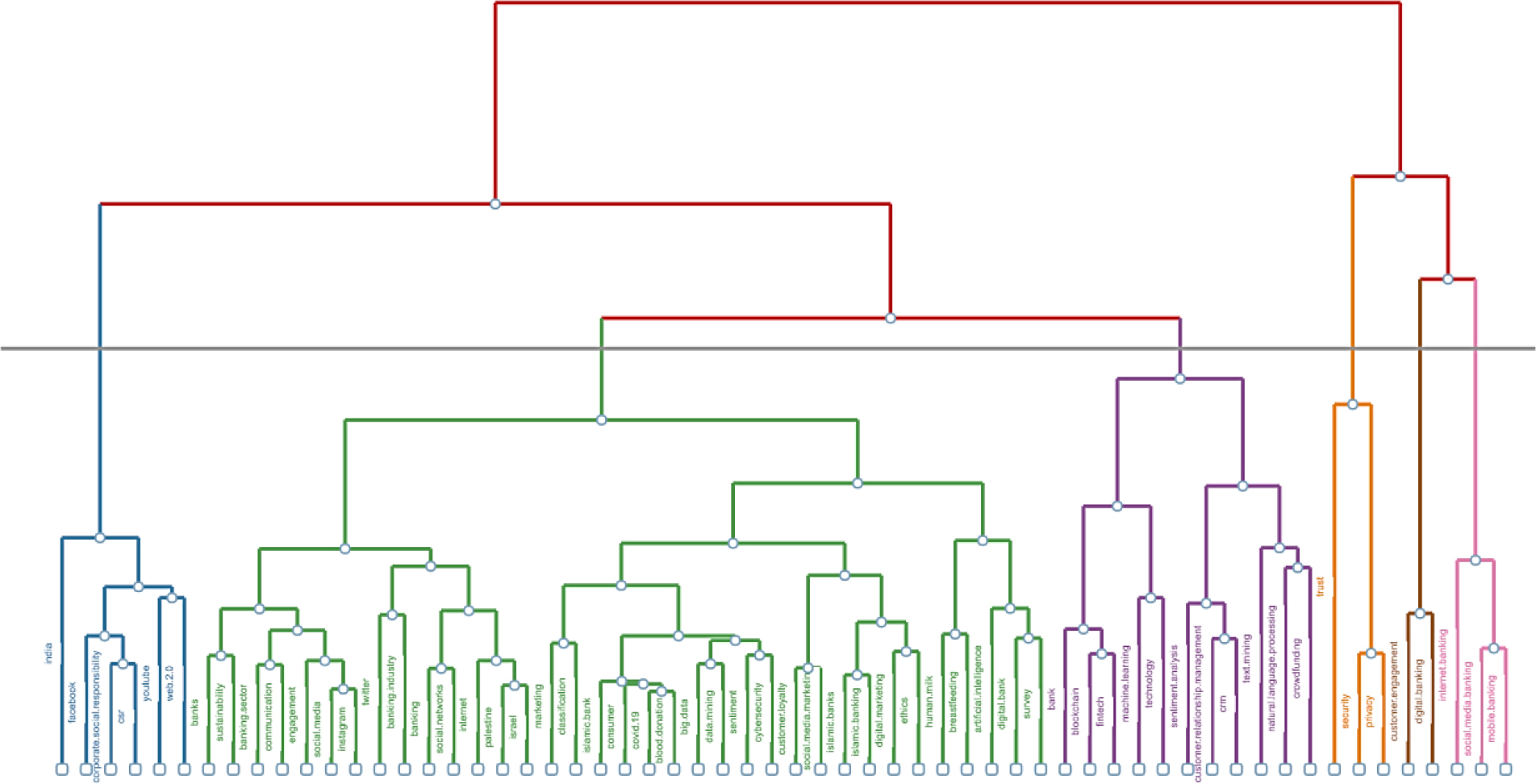
Figure 6:
Topic Dendrogram.
In each primary cluster, there are sub-clusters that group more specific topics together, showing more detailed relationships between them. For example, within the green cluster, there are sub-clusters that combine “artificial intelligence,” “machine learning,” “sentiment analysis,” and “digital bank,” indicating a close relationship among these technologically oriented topics. The connections between clusters demonstrate how some topics connect broader themes, such as how “customer management” and “digital marketing” relate customer-centric themes with broader marketing strategies. Overall, the topic dendrogram in Figure 6 provides a comprehensive visualization of the hierarchical relationships among research topics in social media banking, highlighting primary thematic clusters and revealing the interconnections and sub-clusters within these broad themes. This helps to understand the landscape of research topics, showing broad and specific areas of interest and how they relate to each other in social media banking.
Bibliographic coupling of documents
Figure 7 illustrates a bibliographic coupling network of documents with at least five citations, encompassing 130 items divided into 17 distinct clusters, each represented by a unique color to enhance clarity and differentiation. Cluster 1, the largest with 15 items, includes central works such as Tran H.T.T. and Corner J. (2016) and Alfayad F.S. (2021), reflecting significant research activity in areas like “social media and consumer engagement”. Cluster 2 focuses on marketing and digital engagement, anchored by influential works like Goi C.L. (2014), while Cluster 3 highlights themes of consumer behavior and the effects of social media, with key contributions from Lappeman J., Clark R., and Evans J.. Emerging research trends are evident in Cluster 6, which features recent studies such as Shi Q. and Sun X. (2020), pointing to newer areas gaining scholarly attention. Central nodes, such as Mitic M. and Kapoulas A. (2012), serve as foundational hubs due to their strong connections across multiple clusters, indicating their pivotal role in shaping the broader research landscape. The edges between nodes represent bibliographic coupling, highlighting shared references and thematic coherence among documents. The clusters, ranging from established research domains to emerging topics, are organized with optimized spacing and clear visual separation, making it easier for readers to identify and distinguish between thematic areas within the network. This visualization underscores the depth and breadth of scholarly activity in “social media banking”, providing insights into its key areas of focus and evolving trends.
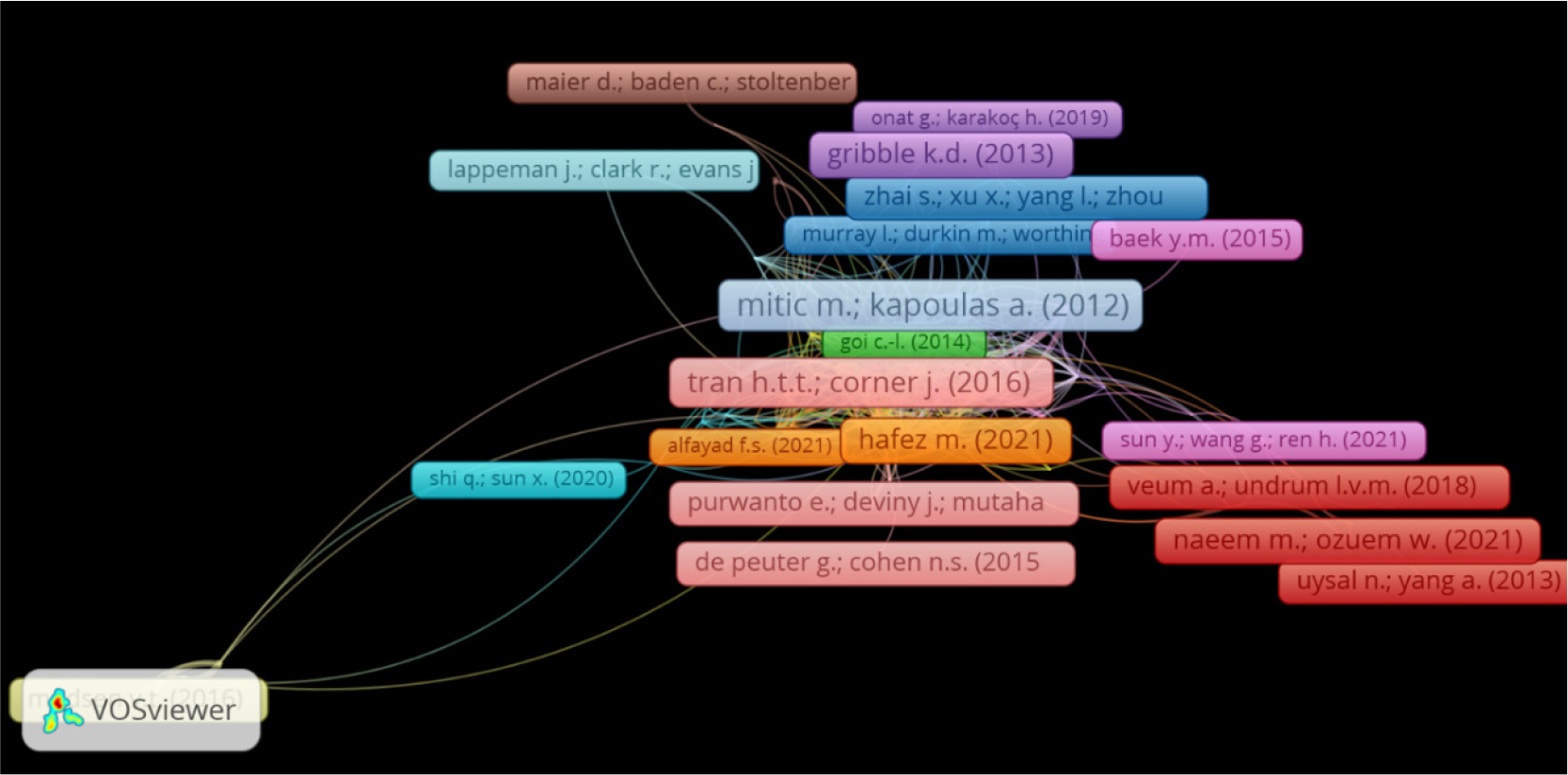
Figure 7:
Bibliographic coupling of documents.
Co-occurrence of all keywords
Figure 8 shows a visualization of keyword co-occurrence in social media banking, using VOSviewer. The network includes 264 keywords, meeting a minimum occurrence threshold of five out of 4952 keywords. The visualization is divided into six clusters, each represented by different colors, indicating distinct thematic areas within the field. Cluster 1 (red) is the largest with 99 keywords, focusing on security and sentiment analysis, featuring prominent terms such as “sentiment analysis,” “computer crime,” “phishing,” “authentication,” and “surveys.” Cluster 2 (green) consists of 61 keywords, emphasizing the interplay between social media platforms and banking, with key terms like “social media,” “banking,” “engagement,” “corporate social responsibility,” and “YouTube.” Cluster 3 (blue), containing 43 keywords, intersects with health and education, highlighting the impact of the COVID-19 pandemic through terms like “human,” “COVID-19,” “procedures,” “medical education,” and “training.” Cluster 4 (yellow) comprises 34 keywords and focuses on geographical studies, health attitudes, and methodological approaches, including terms such as “United States,” “cross-sectional study,” “attitude to health,” “prospective study,” and “mobile applications.” Cluster 5 (purple) includes 25 keywords, emphasizing economic aspects, banking practices, and corporate responsibility, particularly in Islamic banking and mobile banking technologies, with terms like “Islamic banks,” “corporate social responsibility,” “banking,” “economics,” and “mobile bankings.” Cluster 6 (cyan), the smallest with just 2 keywords, represents niche health-related research with terms like “human milk banks” and “prospective study.” This visualization highlights the diverse and interconnected research themes within social media banking, showcasing established areas of interest and emerging trends.
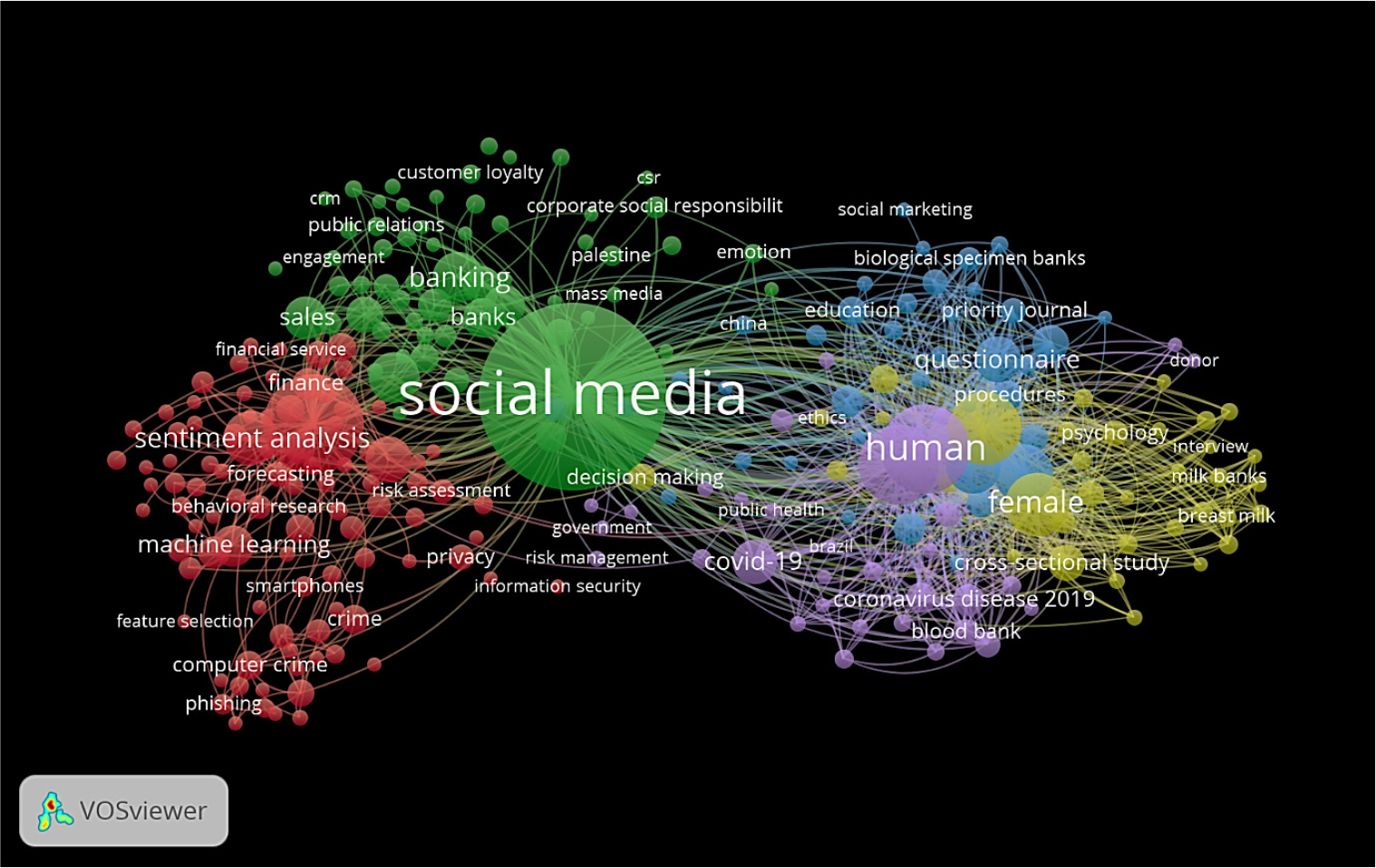
Figure 8:
Co-occurrence of all keywords.
Keywords with strongest Citation Bursts
Figure 9 presents the top 12 keywords with the strongest citation bursts in the field of social media banking from 2007 to 2024. The table includes information on the keywords, the year they started gaining significant attention (Year), the strength of the citation burst (Strength), the beginning and end years of the burst (Begin, End), and a visual representation of the burst period in the timeline from 2007 to 2024. The analysis hereby shows that different research topics are more or less prominent over time, indicating a scholarly shifting of focus and interest. Of the keywords, “internet banking” had a strong citation burst from 2009 to 2018, thereby showing continuous interest and research in this area. On its part, “Social networking (online)” recorded the highest strength of 6.88 from 2014 to 2017, suggesting that within that time frame came the peak period of research activity on it. Other major keywords identified include “big data” from 2014 to 2018, “sales” from 2016 to 2018, and “surveys and questionnaires” from 2017 to 2021, pointing to very radial spheres of interest. Further bursts can be observed with keywords like “blood bank” from 2021 to 2022 and “coronavirus disease 2019” from 2022 to 2024, denoting the impacts of the COVID-19 pandemic on picture trends. This kind of visualization reflects that research conducted in social media banking is dynamic in nature and makes a valuable contribution toward understanding how topics of interest have changed over time.
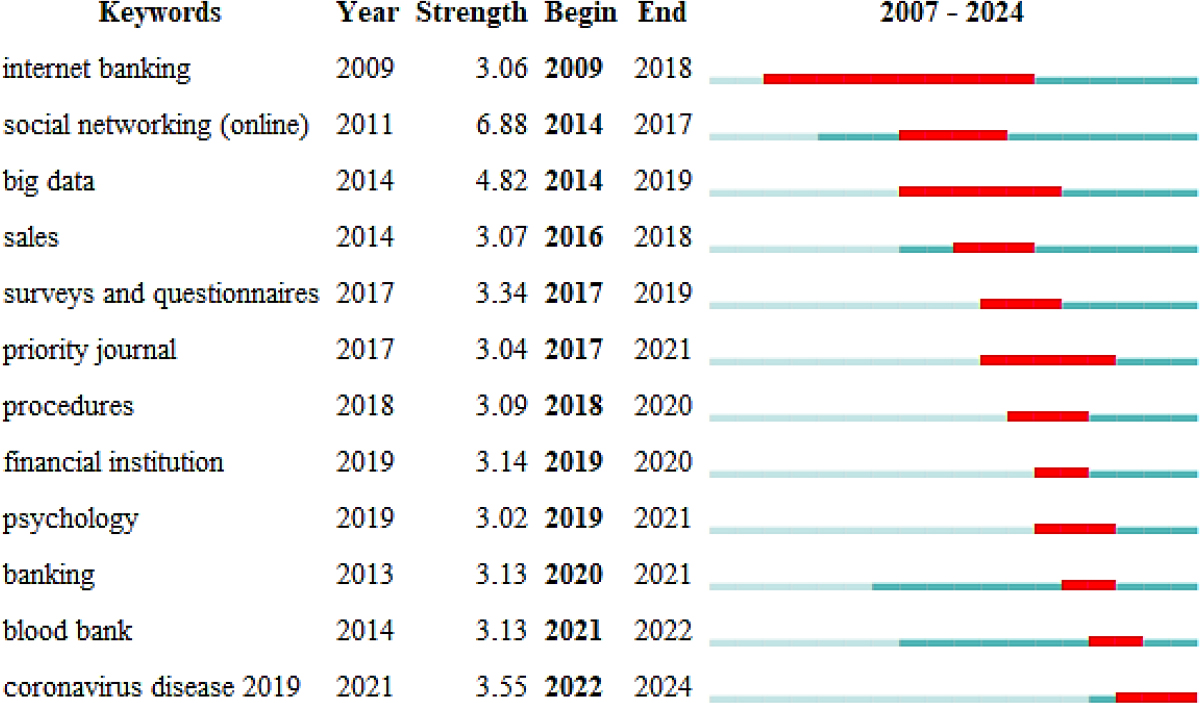
Figure 9:
Keywords with strongest Citation Bursts.
Time zone Network Visualization of Cited Authors
Figure 10 illustrates a time zone network visualization of co-citation among cited authors, organized into 14 distinct clusters. Each cluster is characterized by thematic labels, major citing articles, and the most frequently cited authors, with color-coding to differentiate them. The size of each cluster reflects the number of members and the strength of their citations. Cluster #0, labelled “Social Networking Platform,” stands out as the largest cluster; the clusters have different colours and sizes, indicating member and citation strength. The largest cluster in impact, cluster #0, has the name “Social Networking Platform” and contains 65 members, with key contributors such as Fornell C, Henseler J, and Alalwan AA. The major citing article of this cluster is Hafez, M (2022), who studied the influence of social media marketing activities on brand equity of the banking sector. This cluster is representative of broad interest at the junction between social media and banking, with an apparent focus on social media networking websites and financial technology services. Cluster #1 is identified as “Social Media Brand Personality” and has 60 members with major contributors like Hair JF, Kotler P, and Hennig-Thurau T. Through this, it talks about the impact of social media on brand personality and loyalty in the banking industry. Cluster #2, “Social Media Site,” has an equal number of members and gives a discussion of CSR communication and its impact on consumer behaviour. Most of the cited members are Mitic M, Davis FD, and He W. Cluster #3, “CSR Communication,” highlights the strategic importance of corporate social responsibility in engaging with consumers, featuring key contributors like Gupta S, Kim J, and Fatma M. Smaller clusters, such as Cluster #12, labeled “Quick Response Code Loyalty Promotion Acceptance,” explore niche areas like the acceptance of QR codes for loyalty promotions, indicating specific consumer behavior and technological adoption trends. This comprehensive visualization highlights the breadth and depth of research themes within social media banking, showcasing established and emerging scholarly interest areas.
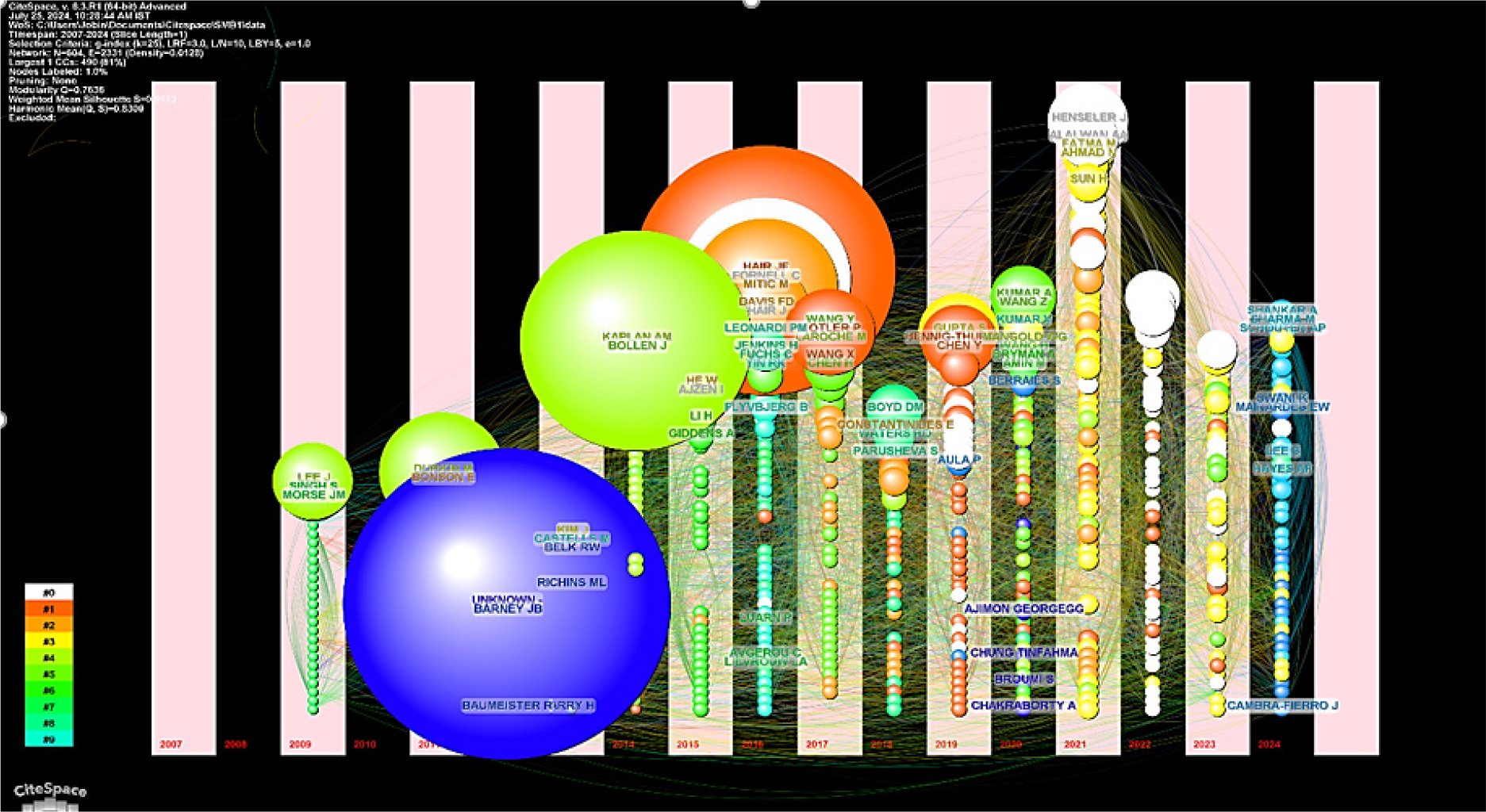
Figure 10:
Time zone Network Visualization of Cited Authors.
Network Visualisation of Co-Citation Cited Journals
Figure 11 presents a network visualization of co-citation among cited journals in social media banking, highlighting 13 clusters. Each cluster is identified by labels, major citing articles, and most cited members, showcasing thematic areas within the field. The largest cluster, Cluster #0, labeled “Corporate Reputation Management,” has 163 members with a silhouette value of 0.713. The major citing article is Ioannou, M (2012), which focuses on the relationships between banks and SMEs in a changing economic and technological environment. The most cited members in this cluster include 33 citations to Fornell C, 15 to Henseler J, and 11 to Alalwan AA. This cluster underscores the significant focus on managing corporate reputation and social responsibility within the banking sector.
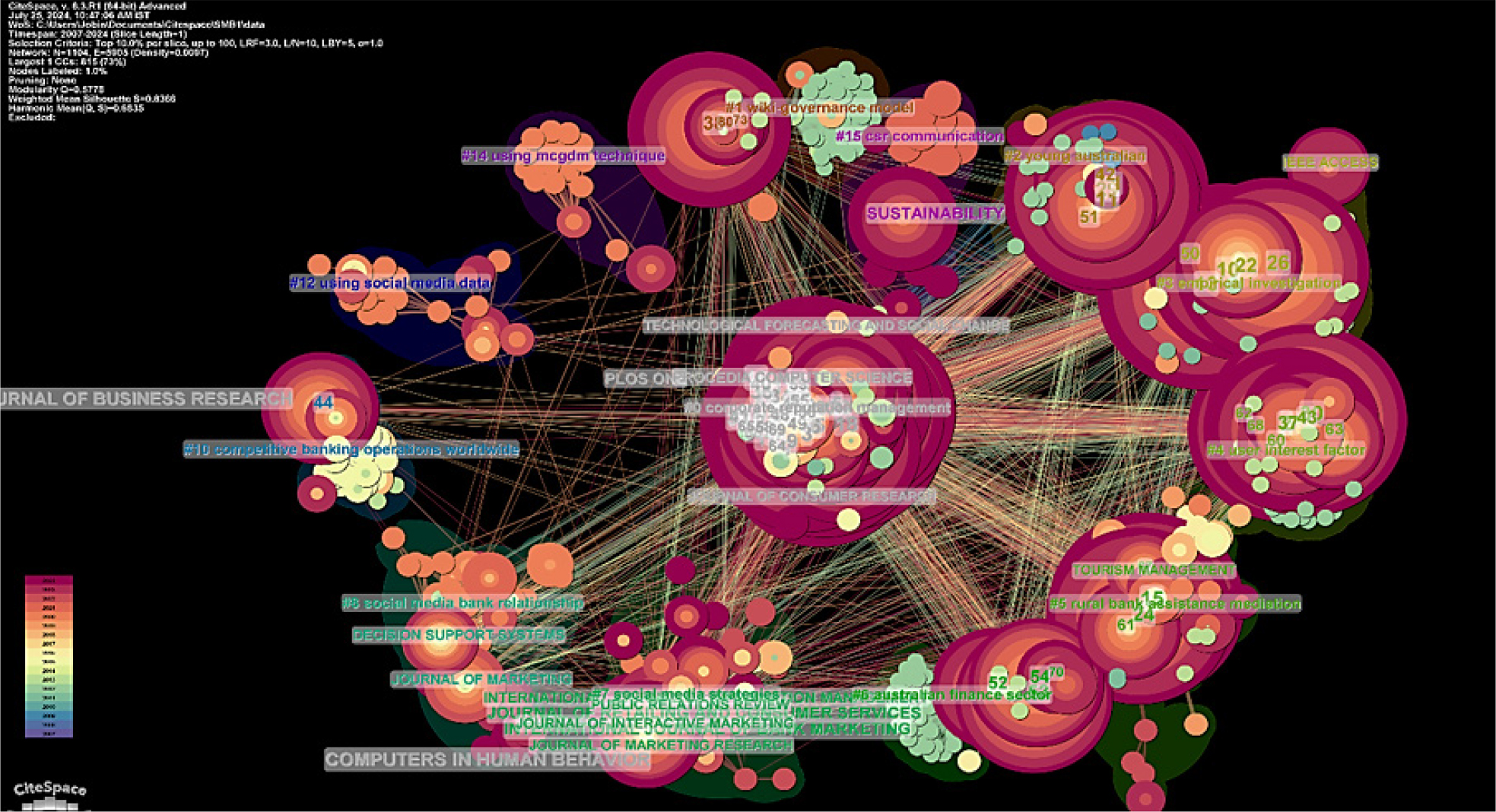
Figure 11:
Network Visualisation of Co-Citation Cited Journals.
Cluster #1, labeled “Wiki-Governance Model,” comprises 86 members with a high silhouette value of 0.971, indicating clear thematic coherence. Dove, Es (2012), with a major citing article on a wiki-governance model for biobanks, is a key contributor. The most cited members include 49 citations to the International Journal of Bank Marketing, 45 to the Journal of Retailing and Consumer Services, and 32 to the International Journal of Information Management. Other notable clusters include Cluster #2, “Young Australian,” with 84 members and key citations focusing on social media and financial relationships, and Cluster #3, “Empirical Investigation,” with 79 members emphasizing the role of social media in bank marketing. These clusters collectively highlight the diverse research interests ranging from social media strategies and CSR communication to specific demographic studies and technological impacts on banking practices.
Cluster #4, labeled “User Interest Factor,” has 78 members and focuses on the impact of blogs and social media on bank reputation and profitability. The major citing article by Christakou, Er (2013) discusses the new word of mouth through social media. The most cited members include 18 citations to Wang Y and 12 to Bollen J. Cluster #5, “Rural Bank Assistance Mediation,” with 75 members, addresses peer-to-peer milk donor experiences and the perception of donor milk banks, reflecting a unique intersection of banking and health-related social media use. Clusters like Cluster #6, “Australian Finance Sector,” and Cluster #7, “Social Media Strategies,” continue to explore regional and strategic aspects of social media banking, indicating robust thematic diversity.
The network further includes smaller but significant clusters such as Cluster #8, “Social Media Bank Relationship,” focusing on the relationship between social media and firm value, and Cluster #9, “Internal Social Media,” examining the use of internal social media for organizational communication. The diversity in research topics extends to Cluster #10, “Social Media Influencer Credibility,” and Cluster #11, “Resources Integrator,” emphasizing the role of influencers and resource management in social media banking. Clusters #12 and #14 focus on using social media data and employing advanced techniques like MCGDM, respectively, indicating methodological advancements. Finally, Cluster #15, “CSR Communication,” underscores the importance of sustainability communication in banking, reflecting the ongoing emphasis on CSR and its impact on consumer loyalty. This comprehensive visualization provides insights into the interconnected research themes and influential journals shaping the field of social media banking.
Timeline Network Visualization of Countries’ Collaborations
The timeline network visualization of country collaborations depicted in Figure 12 reveals distinct clusters, each characterized by different thematic focuses and citation patterns. The largest cluster (#0), labeled “Islamic Bank,” comprises 37 members with a silhouette value of 0.799. It is associated with Islamic banking, social media, and the effects of pandemics. The most significant citing article is by Kral, J (2023), discussing differences in IBD care across Europe. The most cited members within this cluster include India (131 citations), the United States (119 citations), and the United Kingdom (70 citations). Cluster #1, named “Integrated Model,” includes 24 members and has a high silhouette value of 0.888. This cluster is associated with integrated models and web application vulnerabilities, with the same citing article by Kral, J (2023). The most cited members are Turkey (28 citations), Denmark (13 citations), and the Russian Federation (11 citations).
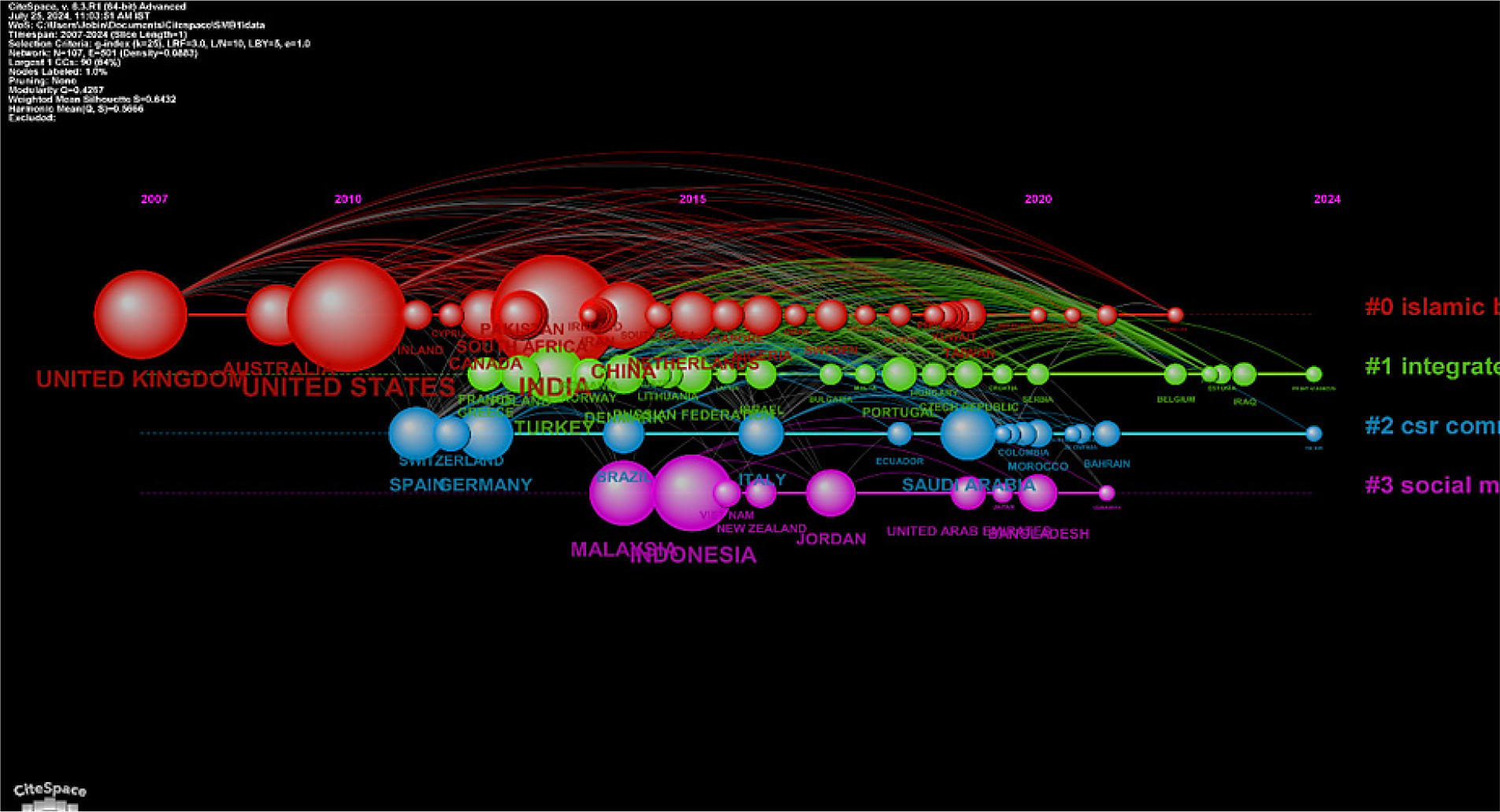
Figure 12:
Timeline Network Visualization of Countries’ Collaborations.
Cluster #2, termed “CSR Communication,” consists of 17 members with a silhouette value of 0.882, focusing on CSR communication, social media, and the Islamic banking sector. Robertson, Fc’s (2020) article on professional development in neurosurgery is a key citing work, with Germany, Spain, and Saudi Arabia each having 25, 25, and 24 citations respectively. Cluster #3, also labeled “Islamic Bank,” includes 9 members with a silhouette value of 0.8, covering topics related to Islamic banking and fraud risk management. The major citing article here is by Habes, M (2023), discussing e-marketing in Jordan. Indonesia (51 citations), Malaysia (36 citations), and Jordan (18 citations) are the most cited members. Finally, Cluster #4, “Pandemics Effect,” is the smallest with 3 members and the highest silhouette value of 0.944. It addresses the impact of COVID-19 on healthcare, with a significant citing article by Wahlster, S (2021). The USA, Cambia Health Foundation, and Kosovo are the most cited members, with 4, 1, and 1 citations, respectively.
DISCUSSION
The bibliometric analysis of social media banking research from 2007 to 2024 reveals a significant annual growth rate of 27.83%, highlighting robust scholarly interest and collaboration, with contributions from 2,494 authors across 794 documents averaging 8.69 citations each, demonstrating the contemporary and impactful nature of the field. The annual scientific production from 2007 to 2024 shows a robust and consistent increase, particularly over the last decade, reflecting growing academic interest and activity. The most prolific authors in the realm of research, led by Ahmad N with six articles, demonstrate significant contributions and influence in the field, with other notable authors such as Bolat N, Chandani A, Mehta M, Naeem M, Sharma M, and Taskiran N.O each publishing five articles, indicating their substantial and consistent academic output. The “Journal of Islamic Marketing” leads as the most impactful with 9 articles, followed by the “ACM International Conference Proceeding Series” and “Communications in Computer and Information Science” each with 8 articles, illustrating the diverse and interdisciplinary nature of the field’s key publications. The most globally cited, led by Wesselius HM’s 2018 paper with 176 citations and a normalized count of 10.05, demonstrates significant impact and influence in the field. Wahlster S’s 2021 paper, with the highest number of citations per year at 27.5 and a normalized count of 9.15, along with other notable papers, highlights both foundational and recent influential studies, underscoring the evolving nature of research in this domain.
The thematic map categorizes keywords and identifying Motor Themes like “blockchain,” “fintech,” and “customer engagement” as both highly developed and central to driving the field forward. In contrast, Emerging or Declining Themes such as “artificial intelligence” and “big data” are less developed and less central, while Basic Themes like “social media” and “privacy” are fundamental but not as specialized or advanced as the Motor Themes. The historiograph highlights influential documents, with foundational works like Mitic M, 2012 showing widespread influence, central clusters around authors like Durkin M and Ozdoora-Aksak, and emerging connections in recent papers like Wang P, 2021, demonstrating evolving networks and key contributions in the field. The topic dendrogram visualizes hierarchical clustering of research topics, revealing primary thematic clusters such as technological advancements and their impact on banking practices, customer-centric themes and marketing strategies, and the regulatory aspects connected with rising technologies, illustrating the interconnections and detailed relationships among these topics.
The bibliographic coupling network visualization reveals 17 clusters among 130 highly cited documents in social media banking, with the most significant clusters highlighting established research areas such as consumer behavior, marketing, and digital engagement, while smaller clusters indicate emerging trends and niche topics, emphasizing the breadth and depth of scholarly activity in the field. The keyword co-occurrence visualization identifies six distinct thematic clusters, highlighting key areas such as security and sentiment analysis, the interplay between social media platforms and banking, the impact of COVID-19, geographical and health studies, economic aspects of banking practices, and niche health-related research, demonstrating the field’s diversity and interconnectedness. The analysis of keywords with the strongest citation bursts from 2007 to 2024 reveals dynamic research trends, with notable bursts for “internet banking” from 2009 to 2018, “social networking (online)” peaking from 2014 to 2017, and recent spikes for “coronavirus disease 2019” from 2022 to 2024, indicating shifting scholarly focus and interest over time.
The time zone network visualization of co-cited authors reveals 14 distinct clusters, with Cluster #0 (“Social Networking Platform”) being the largest and most impactful, featuring key contributors like Fornell C, Henseler J, and Alalwan AA, and highlighting the intersection of social media and banking, while other clusters like “Social Media Brand Personality” and “CSR Communication” emphasize the influence of social media on brand personality and corporate social responsibility in the banking sector. The timeline network visualization of cited journals highlights 13 The network visualization of co-citation among cited journals in social media banking reveals 13 clusters, with the largest cluster, “Corporate Reputation Management,” highlighting the significant focus on managing corporate reputation and social responsibility, while other clusters emphasize diverse research interests such as social media strategies, CSR communication, demographic studies, and technological impacts on banking practices. The timeline network visualization of country collaborations reveals distinct thematic clusters, with the largest cluster focusing on Islamic banking, social media, and pandemics, highlighting significant collaborations and citation patterns among countries like India, the United States, and the United Kingdom.
The bibliometric analysis clearly indicates several evolving trends in social media banking. One of the most prominent developments is the rise of blockchain and fintech as central themes within the field. These motor themes, categorized as highly developed and crucial to the field’s progression, reflect the increasing integration of secure, decentralized technologies in banking. The trend towards blockchain adoption in banking systems suggests a growing concern over privacy and security, as well as the increasing demand for transparency in financial transactions. Blockchain’s ability to provide secure, immutable records of transactions aligns with the growing importance of trust and security in the digital banking space. This shift highlights a larger trend in the convergence of financial technology and social media platforms, with the potential for blockchain to revolutionize digital payments, customer engagement, and even loyalty programs.
However, emerging themes such as Artificial Intelligence (AI) and big data are also noteworthy. While they are less developed and central in the bibliometric network compared to blockchain and fintech, their presence signals a growing interest in data-driven decision-making and personalized banking experiences. AI has significant implications for automating customer service through chatbots, analyzing consumer sentiment on social media platforms, and providing personalized financial advice. Similarly, big data analytics offers vast opportunities for banks to understand customer behavior, improve risk management, and optimize marketing strategies. Although these themes are still evolving, their growing importance in the context of social media banking cannot be overstated, and their future integration into mainstream banking practices may drive further innovation.
Another critical trend illuminated by this analysis is the profound impact of the COVID-19 pandemic on social media banking research. The citation burst for terms like “coronavirus disease 2019” from 2022 to 2024 highlights how the pandemic has accelerated digital transformation in the banking sector. The sudden surge in online banking activity, alongside increased use of social media for consumer engagement, led to a reevaluation of how banks can leverage these platforms to maintain customer relationships during times of crisis. Research has shifted towards understanding consumer behavior during the pandemic, exploring new opportunities for customer engagement, and addressing challenges in digital security. However, as the world moves beyond the peak of the pandemic, a critical question remains: What is the long-term impact of this shift in consumer behavior on social media banking? Future research should investigate how the rapid adoption of digital banking solutions during the pandemic will shape post-pandemic customer expectations, the role of social media platforms in maintaining trust, and the resilience of banking systems in times of global crises.
Despite the extensive and growing body of research in social media banking, several critical research gaps persist. One of the most notable gaps is the lack of empirical studies that validate theoretical models in real-world banking scenarios. Much of the existing research focuses on conceptual frameworks and theoretical discussions, with relatively few studies conducting fieldwork or case studies to test these models in practice. There is a pressing need for research that bridges this gap, particularly in the context of how social media tools can be effectively integrated into banking services to enhance customer experience while ensuring regulatory compliance.
Furthermore, the security and privacy concerns associated with social media banking have not been sufficiently explored. As digital banking platforms increasingly rely on social media channels for customer interaction, the risk of data breaches, identity theft, and fraud grows. While security-related keywords such as “authentication” and “phishing” feature prominently in the literature, much of the research focuses on general security measures without delving deeply into the specific vulnerabilities created by the convergence of social media and banking. More targeted research is needed to understand how banks can safeguard customer data while ensuring a seamless and engaging digital experience.
Finally, the theme of Corporate Social Responsibility (CSR), especially in relation to Islamic banking, deserves more attention. The growing significance of CSR in the banking sector, as highlighted by the bibliometric analysis, suggests that banks increasingly view their social and environmental impacts as integral to their brand value. However, CSR practices in the context of social media banking remain underexplored. Research should focus on how banks can leverage social media to communicate their CSR efforts effectively, engage with stakeholders, and build trust in their commitment to social and environmental causes.
The findings of this bibliometric analysis align with existing research trends in social media banking. For instance, studies such as those by Parusheva (2017) and Parusheva (2019) underscore the transformative potential of social media platforms in enhancing customer engagement and operational efficiency within the banking sector.[5,6] Similarly, Boontarig and Srisawatsakul (2023) demonstrate how perceived convenience influences adoption among younger demographics, reinforcing our analysis of emerging trends in social media banking adoption.[13] Moreover, Ho and Amin (2023) emphasize the importance of relationship commitment and trust-building in customer learning and interaction through social media banking, which echoes the identified themes of customer loyalty and trust in our thematic map.[31] Finally, the insights from Mani et al., (2019) regarding the differential engagement strategies between public and private banks further corroborate our findings on the varied adoption and integration strategies within the industry.[32] These comparisons highlight the multidimensional role of social media in banking, corroborating the broader implications drawn from this study.
From a practical standpoint, the findings of this bibliometric analysis suggest that banking institutions must innovate and adapt their strategies to integrate social media platforms effectively. This includes adopting advanced technologies such as blockchain and AI to enhance security, optimize customer service, and provide personalized financial products. Moreover, the study underscores the need for banks to focus on trust-building in their online platforms, particularly by addressing security concerns.
On the policy side, the rise of social media banking necessitates stronger regulatory frameworks to ensure that consumer privacy is protected and that financial institutions comply with evolving data protection laws. Policymakers should also consider frameworks that promote the responsible use of social media platforms in banking, ensuring that customer engagement remains transparent, ethical, and secure. In conclusion, while the research landscape of social media banking is diverse and evolving, critical areas such as empirical validation, privacy concerns, and CSR integration remain underexplored. Future research should address these gaps, and the findings should inform practical strategies and policies that allow banks to harness the full potential of social media while ensuring security and compliance.
CONCLUSION
The bibliometric analysis on social media banking highlights a significant evolution within the field, leveraging extensive data from Scopus and employing sophisticated analysis tools like Biblioshiny, VOSviewer, and CiteSpace. This study has effectively mapped the landscape of research through indicators like annual scientific production, prominent authors, key sources, and widely cited documents. The thematic mapping and visualization tools, such as bibliographic coupling, keyword co-occurrence, and historiographs, have demonstrated both the breadth and depth of the scholarly dialogue surrounding social media banking. Despite the robust scientific production, several research gaps and areas need practical exploration, particularly in how social media platforms can further integrate with real-time banking services and regulatory compliance. Future research should prioritize these gaps, focusing on empirical studies that validate theoretical models and investigate the security concerns associated with social media banking. For practical implications, banking institutions are encouraged to innovate by adopting social media strategies that not only enhance user experience but also address security and privacy concerns. This approach will not only meet customer expectations for convenience and accessibility but also strengthen trust and engagement in social media banking platforms.
Cite this article:
Aravind J, Lukose A, Joseph J, Bindhya MS, Simon B. Bibliometric Mapping of Social Media Banking: Analyzing Research Trends and Developments. J Scientometric Res. 2025;14(2):493-509.
References
- Majekodunmi D. Social Media Banking: What do we know?. In: ECSM2017 4th European Conference on Social Media. 2017:373-80. [Google Scholar]
- Majekodunmi D, Harris L. In: Conference on e-Business, e-Services and e-Society. 2016:717-727. [CrossRef] | [Google Scholar]
- Del Sarto N, Bocchialini E, Gai L, Ielasi F.. Digital banking: how social media is shaping the game.. Qual Res Financ Markets.. 2025;17(2):348-69. [CrossRef] | [Google Scholar]
- Sumathi N, Sheela T.. Opinion mining analysis in banking system using rough feature selection technique from social media text.. Int J Mech Eng Technol.. 2017;8(12):274-89. [CrossRef] | [Google Scholar]
- Parusheva S.. Social Media Banking Models: A case study of а practical implementation in banking sector.. Икономически Изследвания.. 2017;3:125-41. [CrossRef] | [Google Scholar]
- Parusheva S.. Social media banking usage from banks’ perspective.. Int J E Bus Res.. 2019;15(1):38-54. [CrossRef] | [Google Scholar]
- Majekodunmi O.. Social Media Banking: a review and investigation into intentions to use;. 2021 [CrossRef] | [Google Scholar]
- Mitic M, Kapoulas A.. Understanding the role of social media in bank marketing.. Mark Intell Plan.. 2012;30(7):668-86. [CrossRef] | [Google Scholar]
- Bhargava VR, Velasquez M.. Ethics of the attention economy: the problem of social media addiction.. Bus Ethics Q.. 2021;31(3):321-59. [CrossRef] | [Google Scholar]
- Masuabi FM, Erasmus LD.. Social media service innovation in South African retail banking: A case study [Internet];. 2017:1859-66. [CrossRef] | [Google Scholar]
- Angelini A, Ferretti P, Ferrante G, Graziani P.. Social media development paths in banks.. J Promot Manag.. 2017;23(3):345-58. [CrossRef] | [Google Scholar]
- Assensoh-Kodua A.. Marketing potentials of the social media tools in the banking market of an emerging country.. Risk Gov Control Financ Markets Inst.. 2016;6(4):257-67. 4Continued2 [CrossRef] | [Google Scholar]
- Boontarig W, Srisawatsakul C.. Social media banking adoption among teenagers: a case study of Northeast Thailand.. ICIC Express Lett.. 2023;17(2):245-54. [CrossRef] | [Google Scholar]
- Jacob DA, Rajeswari M.. Enhancement of customers satisfaction through social media for brand building in banking sector.. Int J Mech Prod Eng Res Dev.. 2018;8:1051-6. [CrossRef] | [Google Scholar]
- Ramasamy M, Subbiah J, Dhrubajyoti B, Ramalingam P.. Bankers’ Perspective on Social Media Banking: A Study with Special Reference to Select Indian Banks. J Multidiscip Sci Res.. 2024;9(2):1-9. [CrossRef] | [Google Scholar]
- Razmak J, Farhan W, El Refae GA.. A roadmap of social networking drivers and challenges in the era of digital banking [Internet];. 2022 [CrossRef] | [Google Scholar]
- Bohlin E, Shaikh AA, Hanafizadeh P.. Social network banking: A case study of 100 leading global banks.. Int J E Bus Res.. 2018;14(2):1-13. [CrossRef] | [Google Scholar]
- Manickam T, Gopalakrishnan S, Hridhya PK, Ravi V, Kalenahalli Muniyanayaka D, Muniraju H, et al. Social media usage in Indian banking and financial institutions [Internet]; 2023.. Global Perspectives on Social Media Usage Within Governments. :68-79. [CrossRef] | [Google Scholar]
- Gandolfo A.. Content shared between banks and users on the social ecosystem: an inductive exploratory inquiry.. Electron Com Res.. 2020;20(4):679-712. [CrossRef] | [Google Scholar]
- Fahamsyah MH, Mawardi I, Laila N, Shabbir MS.. Global Islamic banking development: a review and bibliometric analysis using R-Biblioshiny application.. Muqtasid J Ekon Perbankan Syariah.. 2023;14(1):69-92. [CrossRef] | [Google Scholar]
- Alarcon-Ruiz CA, Maguiña JL, Apolaya-Segura M, Carhuapoma-Yance M, Aranda-Ventrura J, Herrera-Añazco P., et al. Bibliometric analysis of medicinal plants’ original articles from Latin America and the Caribbean region.. J Scientometr Res.. 2023;12(1):79-91. [CrossRef] | [Google Scholar]
- Joseph J, Jose J, Jose AS, Ettaniyil GG, Nair SV. A scientometric analysis of bibliotherapy: mapping the research landscape. Library Hi Tech. 2025;43(2/3):1014-34. [CrossRef] | [Google Scholar]
- . 2023:1-108. [CrossRef] | [Google Scholar]
- Guleria D, Kaur G.. Bibliometric analysis of ecopreneurship using VOSviewer and RStudio Bibliometrix, 1989-2019.. Libr Hi Tech.. 2021;39(4):1001-24. [CrossRef] | [Google Scholar]
- Thangavel P, Chandra B.. Two decades of M-commerce consumer research: A bibliometric analysis using R Biblioshiny.. Sustainability.. 2023;15(15):11835. [CrossRef] | [Google Scholar]
- Jose J, Joseph A, Abraham P, Varghese R.. Transformative pedagogies: a bibliometric journey through adaptive learning systems.. J Theor Appl Inf Technol.. 2024;102(6) [CrossRef] | [Google Scholar]
- Joseph J, Thomas B, Jose J, Pathak N.. Decoding the growth of multimodal learning: A bibliometric exploration of its impact and influence.. Intell Decis Technol.. 2024;18(1):151-67. [CrossRef] | [Google Scholar]
- Van Eck NJ, Waltman L.. Software survey: VOSviewer, a computer program for bibliometric mapping.. Scientometrics.. 2010;84(2):523-38. [PubMed] | [CrossRef] | [Google Scholar]
- Niazi MA.. Review of “CiteSpace: A practical guide for mapping scientific literature” by Chaomei Chen.. Complex Adapt Syst Model.. 2016;4(1):23. [CrossRef] | [Google Scholar]
- Zhang M.. Research on hot topics and trends of Tutor’s guidance style:Citespace-based bibliometric analysis [Internet]; 2023.. ACM International Conference Proceeding Series. :84-91. [CrossRef] | [Google Scholar]
- Ho RC, Amin M.. Exploring the role of commitment in potential absorptive capacity and its impact on new financial product knowledge: a social media banking perspective.. J Financ Serv Mark.. 2023;28(3):585-98. [CrossRef] | [Google Scholar]
- Mani R, Oveis PM, Ilankadhir M, Thiyagarajan S, Janakiraman S.. Customer engagement with social media bank pages with reference to Facebook.. Int J Recent Technol Eng.. 2019;8(2 Special Issue 11):3089-95. [CrossRef] | [Google Scholar]
- Harzing AW, Alakangas S.. Scientometrics.. 2016;106(2):787-804. [CrossRef] | [Google Scholar]
- Baas J, Schotten M, Plume A, Côté G, Karimi R.. Scopus as a curated, high-quality bibliometric data source for academic research in quantitative science studies.. Quant Sci Stud.. 2020;1(1):377-86. [CrossRef] | [Google Scholar]

